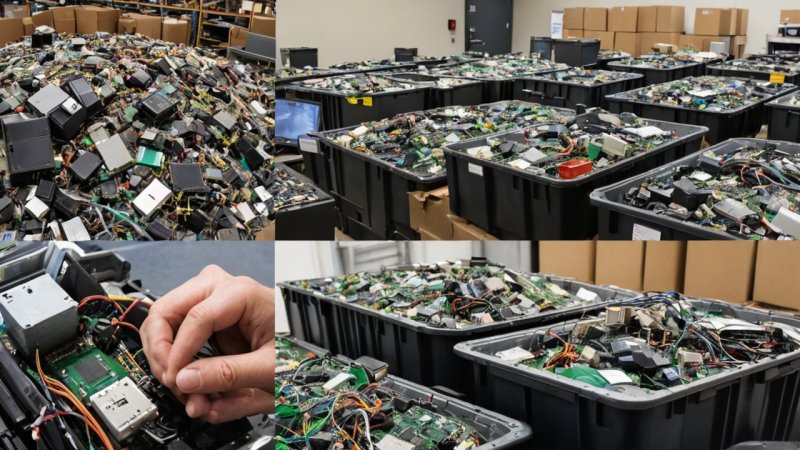The rapid advancement of technology has brought about unprecedented convenience and connectivity, yet it has also given rise to a growing concern: electronic waste, or e-waste. As devices become obsolete at an alarming rate, the environmental and health implications of discarded electronics are becoming increasingly evident. However, engineers and researchers are stepping up to tackle this pressing issue, developing innovative solutions to manage e-waste responsibly. This article explores how engineering is addressing the challenges of e-waste through sustainable design, recycling technologies, and policy advocacy.
The Scope of the E-Waste Problem
According to the Global E-Waste Monitor, an estimated 53.6 million metric tons of e-waste were generated worldwide in 2019, a figure projected to reach 74 million metric tons by 2030. This staggering amount of waste not only contributes to environmental degradation but also poses significant health risks due to the hazardous materials often found in electronic devices. Heavy metals such as lead, mercury, and cadmium, along with flame retardants and other toxic substances, can leach into the soil and water, impacting ecosystems and human health.
Innovative Engineering Solutions
To combat the e-waste crisis, engineers are employing a variety of strategies aimed at reducing waste generation and improving recycling processes. These solutions can be broadly categorized into three main areas: sustainable design, advanced recycling technologies, and the development of circular economy models.
Sustainable Design Principles
One of the most effective ways to address e-waste is to prevent it from being created in the first place. Engineers are increasingly adopting sustainable design principles that focus on creating products that are not only functional but also environmentally friendly. This includes:
- Durability: Designing products that last longer reduces the frequency of replacement and, consequently, the amount of e-waste generated.
- Modularity: Creating devices with interchangeable parts allows for easier repairs and upgrades, extending the product's life cycle.
- Recyclability: Using materials that can be easily recycled ensures that products can be repurposed at the end of their life.
For example, some tech companies have begun to design smartphones that can be easily disassembled, allowing users to replace batteries or screens without needing to buy a new device. This shift towards sustainability in engineering design is critical for reducing e-waste at its source.
Advanced Recycling Technologies
Despite the best efforts to design sustainable products, e-waste will continue to be generated. Therefore, engineers are focusing on improving recycling technologies to recover valuable materials and reduce environmental impact. Some notable advancements in this area include:
- Hydrometallurgical Processes: These methods use aqueous solutions to extract metals from e-waste, significantly reducing the environmental footprint compared to traditional smelting techniques.
- Robotic Recycling: Automation and robotics are being integrated into recycling facilities to enhance the efficiency and accuracy of sorting and processing e-waste.
- Urban Mining: This concept involves extracting valuable materials from electronic devices, such as gold and rare earth metals, which can then be reused in new products.
These technologies not only help recover precious materials but also minimize the hazardous waste that ends up in landfills.
Circular Economy Models
The transition to a circular economy is another critical approach in addressing e-waste. This model emphasizes the importance of reusing and recycling materials rather than following a linear “take-make-dispose” model. Engineers are playing a vital role in developing systems that support this transition, including:
- Product-as-a-Service Models: Instead of selling products outright, companies are offering services that allow consumers to lease devices, ensuring they are returned for refurbishment or recycling.
- Take-Back Programs: Many companies are implementing take-back initiatives, encouraging customers to return old devices for responsible recycling.
- Collaboration with Stakeholders: Engineers are working with governments, businesses, and non-profits to create policies and frameworks that promote responsible e-waste management.
By fostering a circular economy, engineers can help create a more sustainable future while minimizing the impact of e-waste on the environment.
The Role of Policy and Advocacy
While engineering solutions are crucial, effective policy and advocacy are equally important in addressing the e-waste crisis. Engineers are increasingly engaging with policymakers to develop regulations that promote responsible e-waste management. This includes:
- Establishing E-Waste Regulations: Governments are being urged to implement strict regulations on e-waste disposal and recycling practices, ensuring that hazardous materials are handled safely.
- Incentivizing Sustainable Practices: Financial incentives for companies that adopt sustainable design and recycling practices can encourage more businesses to prioritize e-waste reduction.
- Public Awareness Campaigns: Educating the public about the importance of e-waste recycling and responsible disposal is essential for creating a culture of sustainability.
By combining engineering innovation with effective policy, we can create a comprehensive approach to tackling the e-waste crisis.
Conclusion
The challenges posed by e-waste are significant, but through innovative engineering solutions, we can mitigate its impact on the environment and public health. Sustainable design principles, advanced recycling technologies, and the development of circular economy models are all integral to addressing this pressing issue. Moreover, collaboration with policymakers and advocacy for responsible practices will further enhance these efforts. As we move forward in an increasingly digital world, it is crucial to prioritize sustainability in engineering to ensure a healthier planet for future generations.






